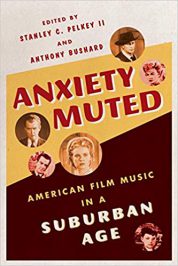In this volume the thirteen contributors research how in audiovisual media of the 1950s and 1960s (TV and cinema), the modern anxieties about conformity, urbanization, gender and family were represented audibly, that is, in sound of any kind or the lack thereof. This could be the soundtrack, music used in the media, but also all kinds of audio sources used to communicate meaning, emotion, or an attitude.
 Another aspect that is stressed is the recent tendency to copy or recreate the style of video and audio recordings of productions from that time (with the most prominent example of Mad Men).
Another aspect that is stressed is the recent tendency to copy or recreate the style of video and audio recordings of productions from that time (with the most prominent example of Mad Men).
Music and the ways it was exploited in distinctive movies (Sunset Boulevard, High Noon, Quo Vadis, The Man who Knew too Much, Cadillac Records, Far From Heaven) is the topic of the fourteen essays of altogether good quality collected here.
Other texts deal with serials (Leave it to Beaver, The Twilight Zone, The Prisoner, Mad Men), musical renditions of physical disability, and the changing role of music in American society, particularly throughout the 1960s but with the title “Anxiety Muted,” many more details and research go into the explanation of why so much film and TV audio can be read as musical equivalent to anxiety, insecurity and national angst. The Cold War tension, political paranoia, the war in Korea and fears of nuclear weaponry after the prosperous and patriotic 1940s and the victory over Hitler prepared a strange and uncomfortable climate of distrust and anxiety for the 1950s and 1960s.
Music may then be interpreted as not only a secondary means of expression but as an actor itself. Nevertheless, musical expression (a theme, variation or a quotation) often conveys matters that cannot be said and remain silent or muted, be it as we witness a remote conversation with actors far away, while we only see them gesturing and their changing facial expressions. But then, what we hear actually is music, or be it that extreme horror, fear, shame or love that is transported musically – keeping in mind the latest fad for all things “retro” in popular culture, especially in fashion and music, almost any essay here lists useful explanations and theories.
One of those (considering TV serials) by editor Stanley C. Pelkey goes like this: “Television is a significant agent in the commodification of nostalgia and the generation of shared, but not necessary lived, experience. From almost the beginning of its broadcast history, television has recycled audiovisual texts. These reruns and old films are not merely relics of a ‘dormant past.’ They form a dynamic ‘television heritage,’ anchoring the past – real and imagined – in the public mind. They also reinforce knowledge of the musical past, which TV composers and producers use to communicate in a narrative form shorter than film but played within a larger broadcast ‘flow’.”
Besides a strong focus on the use of audiovisual media there is also a lot of background information on how the broadcasting business, film editing and character creation used to be handled in the 1950s and 1960s and how that changed, due to political courses or fashionable trends in American society. Anthony Bushard’s piece on Aaron Copland is particularly recommended.
Review by Dr. A. Ebert © 2016
Stanley C. Pelkey and Anthony Bushard (eds.) Anxiety Muted. American Film Music in a Suburban Age. Oxford University Press, 2015, 320p.
